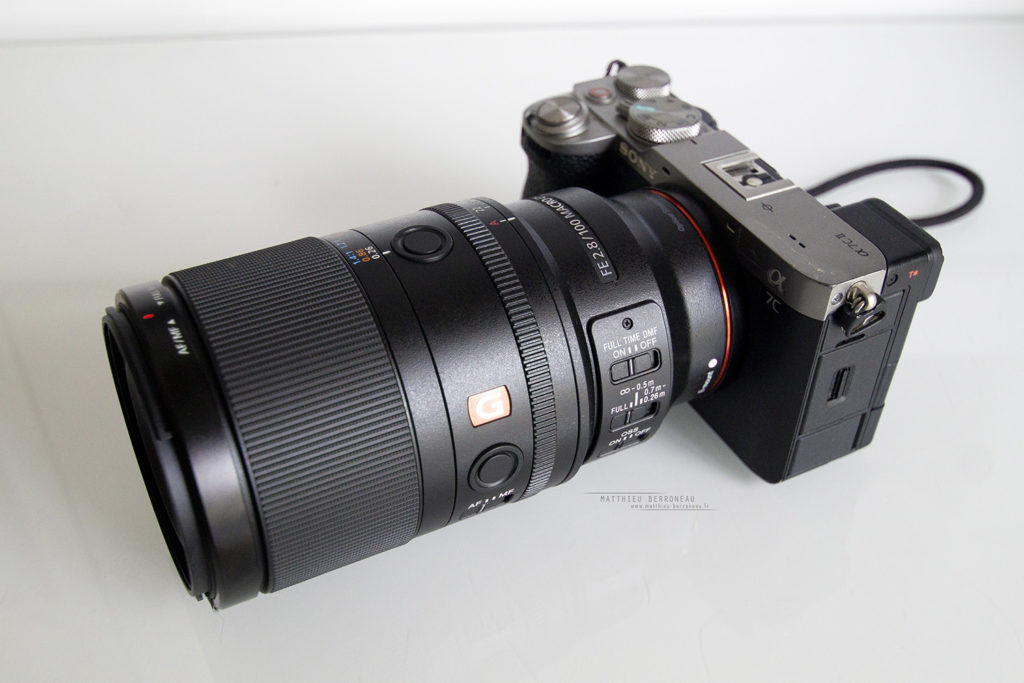Review of Sony FE 100 mm f/2,8 Macro GM OSS: my first impressions of the new macro lens from Sony!
Depuis le début de mon activité de photographe spécialiste des reptiles, amphibiens, et autre petite faune, j’utilise un objectif macro pour 80% de mes clichés. C’est peu dire que c’est un objectif absolument essentiel pour moi. Depuis plus de dix ans, j’utilisais avec le plus grand plaisir le légendaire Sony 90 f2.8 macro.
Cette année, Sony a décidé de rafraîchir cet objectif en proposant son remplaçant naturel, qui s’accompagne d’une montée en gamme, d’une qualité optique, et de nouvelles caractéristiques plutôt intéressantes. Je viens tout juste de le recevoir : voici mes premières impressions !
As a photographer specializing in reptiles, amphibians, and other small wildlife, I use a macro lens 80% of the time. It’s an understatement to say that this lens is absolutely essential for me. Since 2015, I have been happily using the legendary Sony 90 f2.8 macro lens.
This year, Sony decided to refresh this lens by offering its natural replacement, which comes with an upgrade in quality, optical performance, and some rather interesting new features. I just received this new lens, and here are my first impressions!
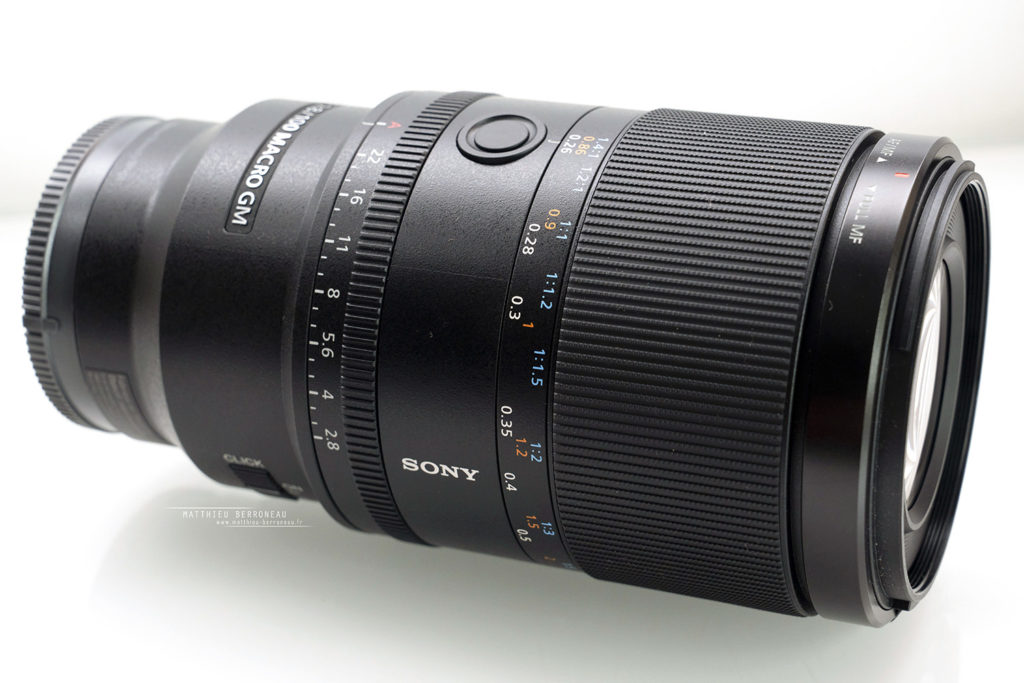
Le Sony FE 100 mm f/2,8 Macro GM OSS appartient comme son nom l’indique à la gamme GM, la gamme la plus haut de gamme de chez Sony. Nous avons déjà un premier signe ici de l’upgrade réalisé depuis le 90 macro, qui n’appartenait qu’à la gamme G.
Le Sony 100 macro reprend globalement le fonctionnement et l’ergonomie générale du 90. Avec notre plus grand bonheur, car nous avons là un objectif extrêmement fonctionnel et ergonomique.
Le Sony 100 macro dispose d’une multitude de boutons raccourcis sur les flancs :
– un switch pour la stabilisation : OSS On / OSS Off.
– un switch pour la distance de mise au point : 0.26 à 0.7 m / 0.5 à l’infini / Full.
– un switch “Full Time DMF” : On / Off. A savoir un système de retouche manuel fine de la mise au point automatique.
On dispose (c’est nouveau) d’une bague d’ouverture sur l’objectif (que l’on peut bloquer ou non, ou encore régler “crantée” ou “glissante”).
Sont présents également deux boutons personnalisables, auxquels nous pouvons assigner, depuis le boîtier, toutes sortes de fonction (pour moi ce sera la loupe d’aide à la mise au point, j’adore).
Enfin, la bague de mise au point, large et douce, permet, en poussant vers l’avant ou en tirant vers l’arrière, de basculer d’AF vers MF. Mais même quand la bague est basculée sur la position Autofocus, la reprise précise de la mise au point en manuel est possible si la fonction DMF est enclenchée.
En bref, l’ergonomie de l’objectif est absolument parfaite, difficile de faire mieux !
The Sony FE 100mm f/2.8 Macro GM OSS belongs, as its name suggests, to the GM range, Sony’s top-of-the-line range. We already have a first sign here of the upgrade from the 90 macro, which belonged only to the G range.
The Sony 100 macro lens generally retains the same functionality and overall ergonomics as the 90. This is great news for us, as it is an extremely functional and ergonomic lens.
The Sony 100 macro lens has a multitude of shortcut buttons on the sides:
– A switch for stabilization: OSS On/OSS Off.
– A switch for focus distance: 0.26 to 0.7 m / 0.5 to infinity / Full.
– A “Full Time DMF” switch: On / Off. This is a system for fine manual adjustment of the autofocus.
There is an (new) aperture ring on the lens (which can be locked or unlocked, or set to “detented” or “smooth”).
There are also two customizable buttons, to which we can assign all kinds of functions from the camera body (for me, it will be the focus assist magnifier, which I love).
Finally, the large, smooth focus ring allows you to switch from AF to MF by pushing it forward or pulling it back. But even when the ring is set to Autofocus, precise manual focus adjustment is possible if the DMF function is enabled.
In short, the ergonomics of the lens are absolutely perfect. It would be hard to do better!
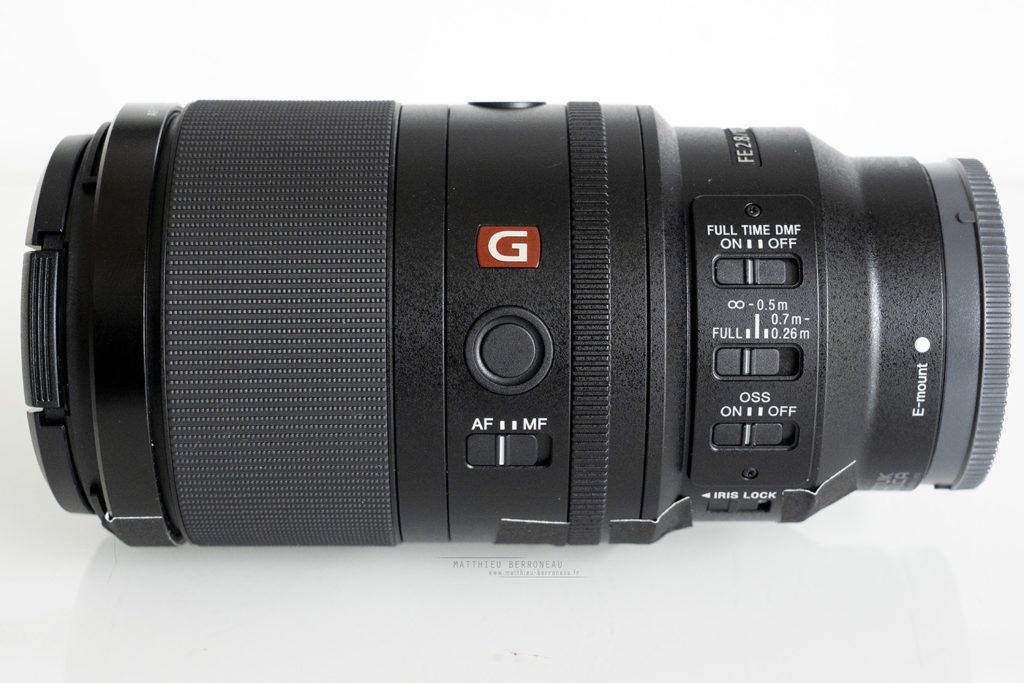
Le tableau suivant propose un comparatif des quatre macros disponibles en monture Sony FE (avec autofocus, exit donc les laowa et autres marques tierces) :
The following table compares the four macros available in Sony FE mount (with autofocus, so no Laowa or other third-party brands):
| Sony 100 macro | Sony 90 macro | Tamron 90 macro | Sigma 105 macro | |
| Dimensions / Size | 81 x 148 mm | 79 x 130 mm | 79 x 126 | 74 x 136 |
| Poids / Weight | 646 g | 602 g | 630 g | 710 g |
| Tropicalisé / Tropicalized | Oui + | Oui | ? | ? |
| Autofocus | Oui (4XD) | Oui (DDSSM) | Oui | Oui |
| Diamètre lentille / Lens diameter | 67 mm | 62 mm | 67 mm | 62 mm |
| Distance map mini / Minimum distance map | 0,26 m | 0,28 m | 0,23 m | 0,29 m |
| Rapport d’agrandissement / Magnification | 1,4:1 | 1:1 | 1:1 | 1:1 |
| Nombre lamelles / Slats number | 11 | 9 | 12 | 9 |
| Supporte les TC / Supporting TC | Oui (x1,4 / x2) | Non | Non | Non |
| Prix officiel / Official price (in France) | 1599 € | 749 € | 699 € | 829 € |
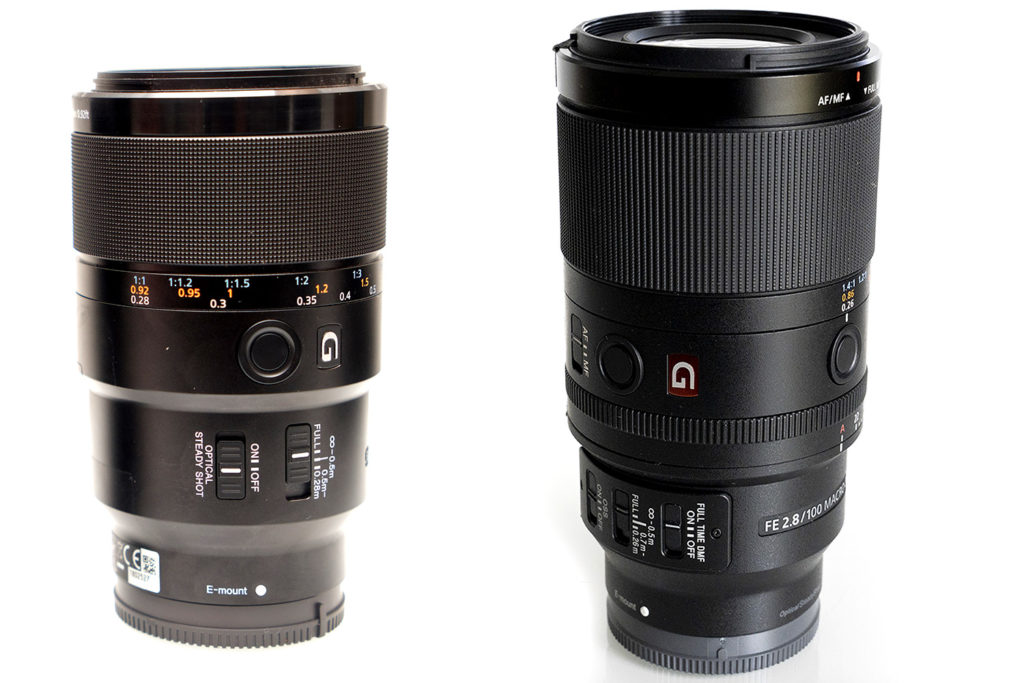

Le fameux rapport de grossissement 1,4:1 ! The famous 1:4:1 magnification!
Dans l’attente du futur Sony a7v, j’utilise pour l’instant cet objectif avec le Sony a7Cii, dont la qualité d’image n’est plus à démontrer. Très clairement, le combo Sony a7Cii x Sony 100 macro délivre des images d’un niveau spectaculaire. Par contre, niveau équilibre, rien d’incroyable : le Sony a7Cii est ridiculement petit est n’est pas vraiment adapté pour recevoir, selon moi, de tels objectifs (on lui préférera les petites focales fixes). Vivement donc l’arrivée du Sony a7v, pour un plus grand plaisir d’utilisation !
While waiting for the future Sony a7v, I am currently using this lens with the Sony a7Cii, whose image quality is well established. Clearly, the Sony a7Cii x 100 macro combo delivers spectacular images. However, in terms of balance, it’s nothing incredible: the Sony a7Cii is ridiculously small and, in my opinion, not really suited to such lenses (small fixed focal lengths are preferable). I can’t wait for the arrival of the Sony a7v, which will be even more enjoyable to use!
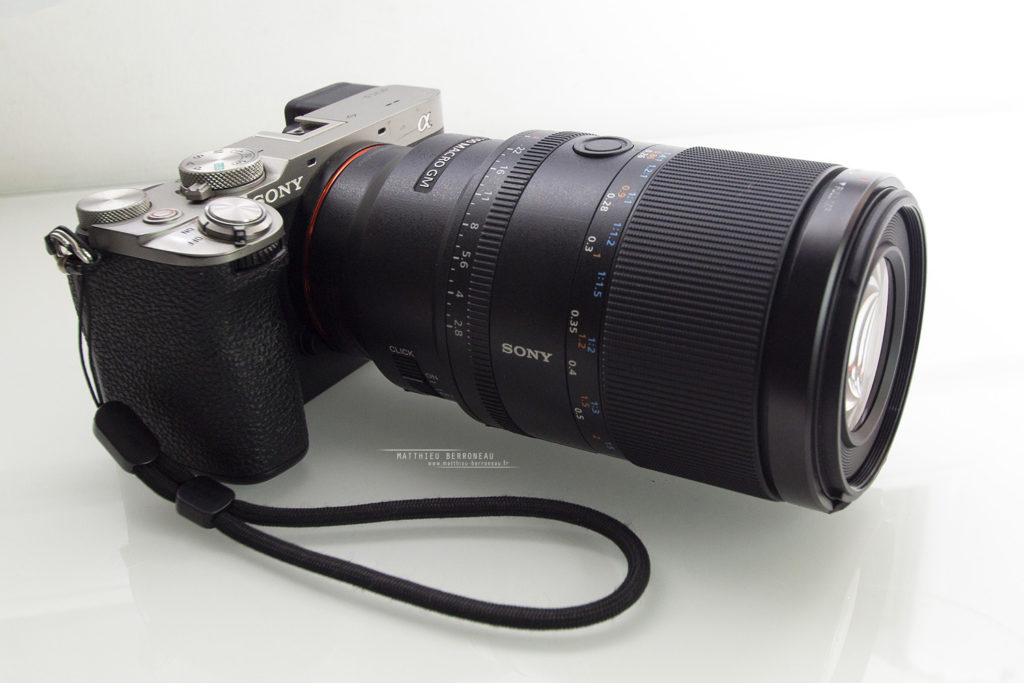
Sony 100 macro & Sony a7Cii
Premières photos / My first pictures
Objectif fraîchement reçu, et mois de novembre oblige, je n’ai pas encore eu l’occasion de faire des centaines de photos. Mais les premiers clichés sont, évidemment, très concluants. Le piqué de l’objectif est tout bonnement exceptionnel, et ce même dès la pleine ouverture. Le bokeh est d’une superbe douceur. Un régal. L’autofocus, contrairement au 90, est quasi inaudible, et surtout extrêmement rapide. On a du mal à croire qu’il s’agisse d’un objectif macro, c’est là un énorme progrès !
I just received this lens, so I haven’t had a chance to take many photos with it yet. But the first shots are, of course, very convincing. The sharpness of the lens is simply exceptional, even at full aperture. The bokeh is beautifully smooth. A real treat. Unlike the 90, the autofocus is virtually silent and, above all, extremely fast. It’s hard to believe that this is a macro lens, it’s a huge improvement!

Vipera aspis – Sony FE 100 Macro GM – f4.5 – 1/100s – iso 160
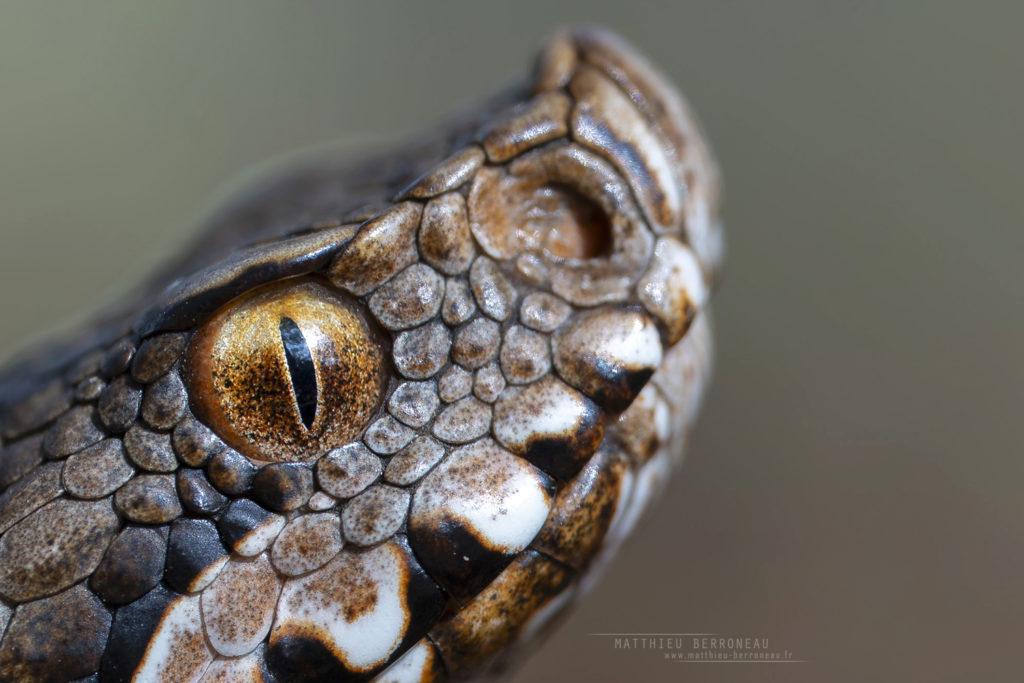
Crop à 100%
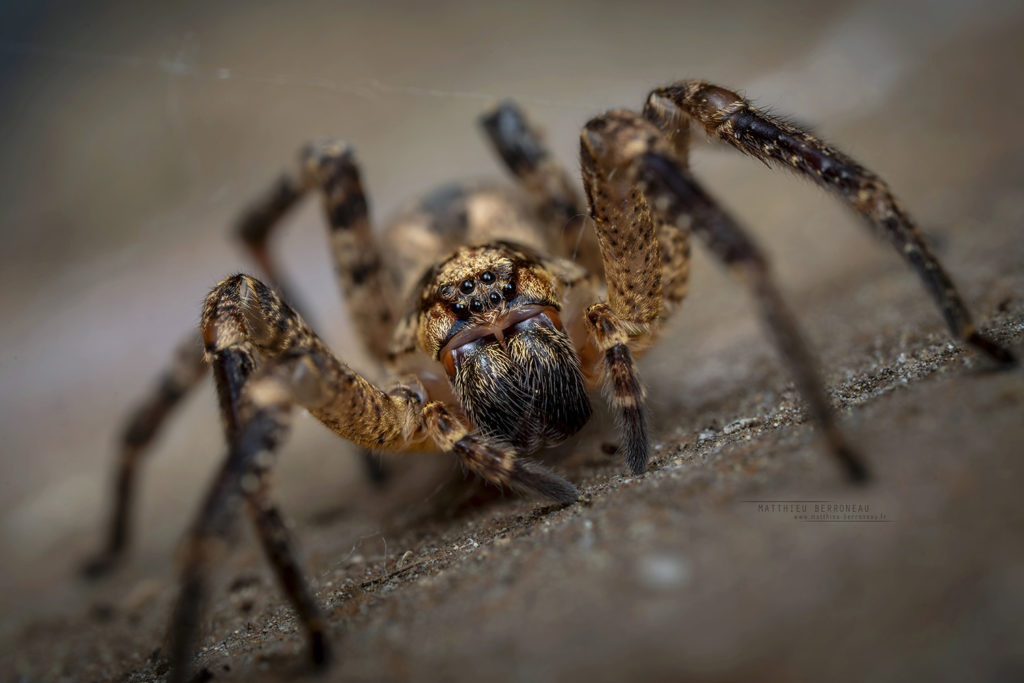
Hogna radiata – Sony FE 100 Macro GM – f11 – 1/160s – iso 200
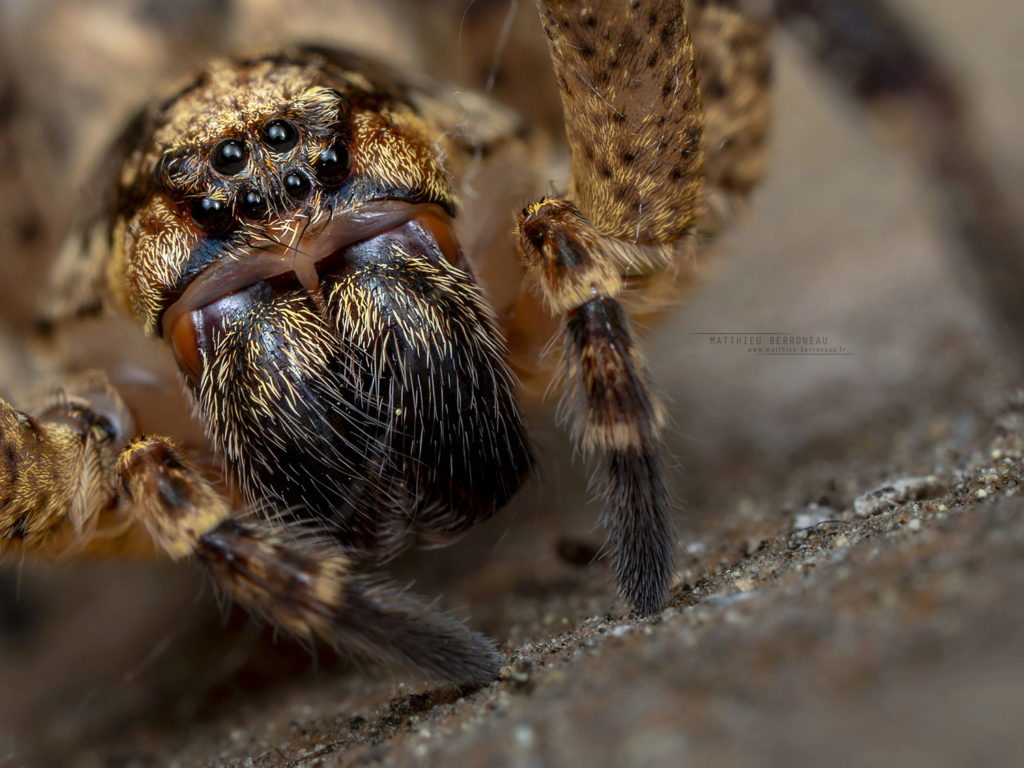
Crop à 100%
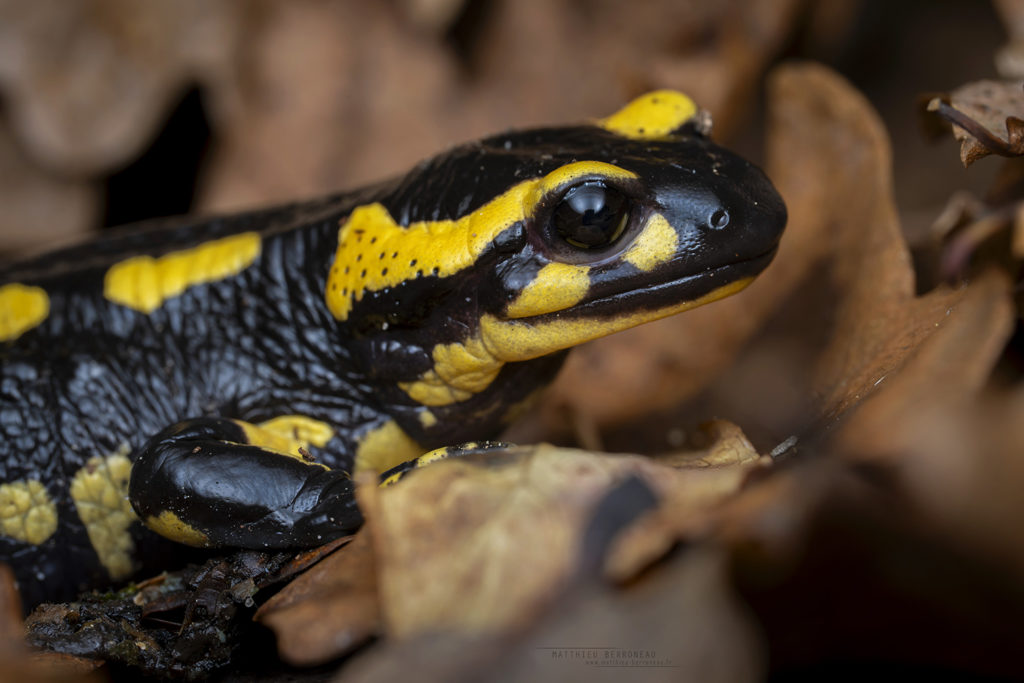
Salamandra salamandra – Sony FE 100 Macro GM – f10 – 1/160s – iso 250
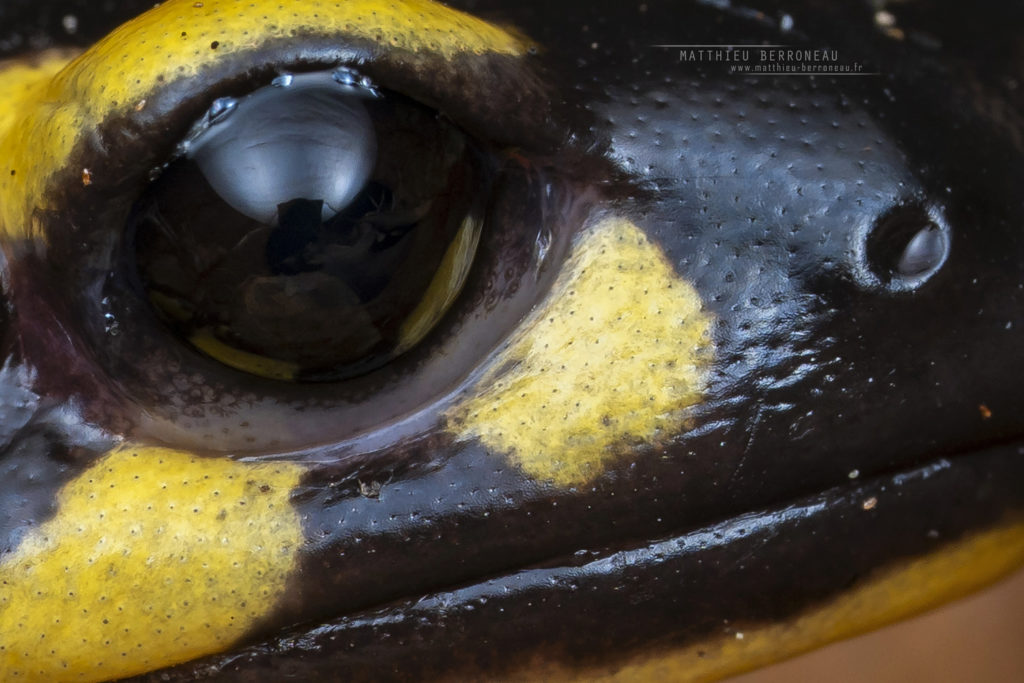
Crop à 100%
Voici 3 clichés présentant la même prise de vue, avec trois ouvertures différentes : f2.8, f5.6 et f7.1. On apprécie les différences de profondeur de champ et la douceur du bokeh.
Here are three shots showing the same scene, taken with three different apertures: f2.8, f5.6, and f7.1. Note the differences in depth of field and the smoothness of the bokeh.

Vipera aspis – Sony FE 100 Macro GM – f2.8 – 1/100s – iso 125
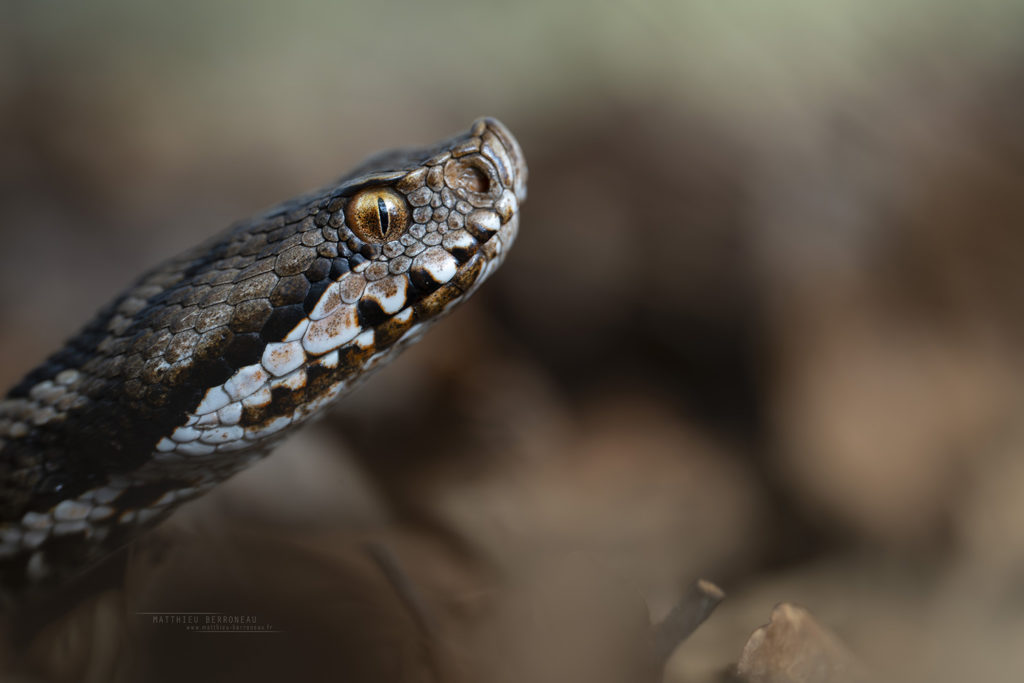
Vipera aspis – Sony FE 100 Macro GM – f5.6 – 1/100s – iso 400
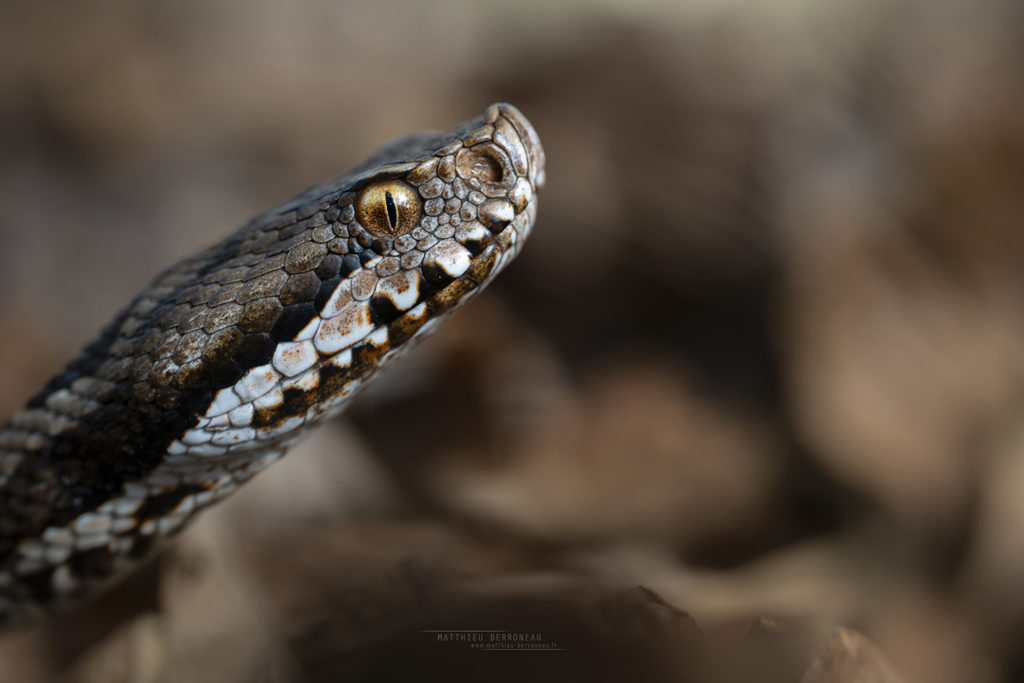
Vipera aspis – Sony FE 100 Macro GM – f7.1 – 1/100s – iso 800
J’ai également pu tester le rapport de grossissement 1,4:1, et le comparer sur le terrain au rapport de grossissement 1:1 où j’étais bloqué par le passé. Plus que des mots, voici quelques photos permettant d’apprécier la différence entre les deux rapports de grossissement.
I was also able to test the 1.4:1 magnification ratio and compare it in the field to the 1:1 magnification ratio, which had previously limited my capabilities. Rather than relying on words, here are a few photos that illustrate the difference between the two magnification ratios.

Vipera aspis – Sony FE 100 Macro GM – f4 – 1/100s – iso 500 – rapport 1:1

Vipera aspis – Sony FE 100 Macro GM – f4 – 1/100s – iso 640 – rapport 1,4:1

Hogna radiata – Sony FE 100 Macro GM – f9 – 1/160s – iso 200 – rapport 1:1
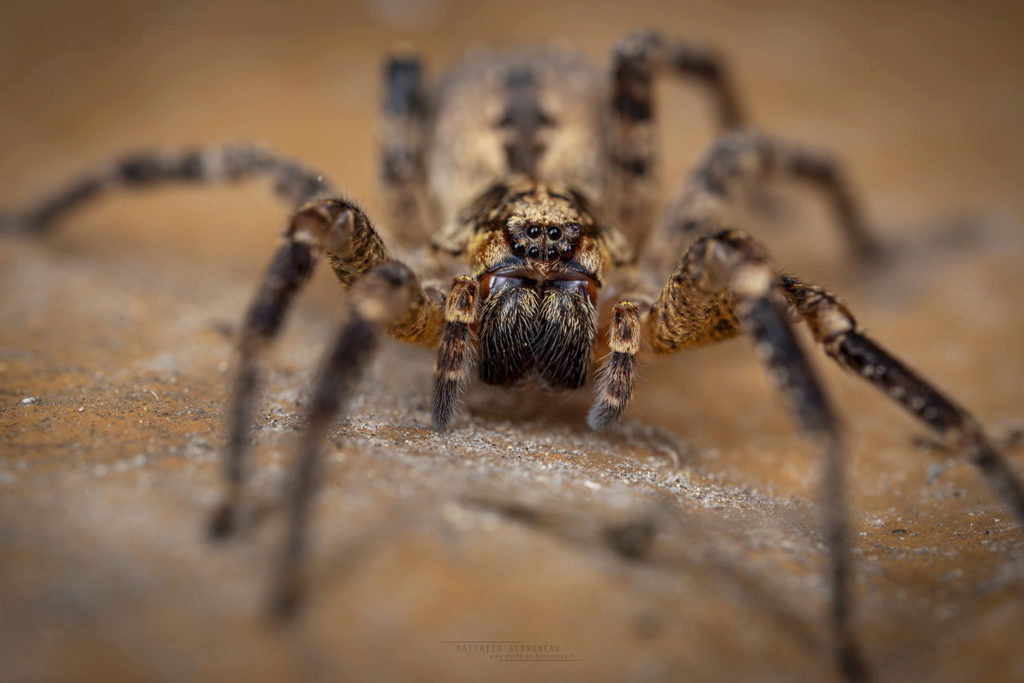
Hogna radiata – Sony FE 100 Macro GM – f9 – 1/160s – iso 200 – rapport 1,4:1
Je suis remonté dans mes disques durs pour comparer quelques clichés réalisés avec mon ancien Sony 90 macro. Ce dernier était déjà exceptionnel, et la différence de piqué ne semble pas flagrante. Elle existe toutefois, et a d’ailleurs été mise en évidence par les testeurs “professionnels”, sur la base de test de mire etc. Le piqué du nouveau 100 macro est ainsi toujours supérieur, et tout particulièrement dans les coins, où il reste toujours de très haut niveau, alors qu’il avait tendance à baisser chez le 90.
I tried searching through my hard drives to compare a few shots taken with my old Sony 90 macro lens. The latter was already exceptional, and the difference in sharpness does not seem obvious. However, it does exist and has been highlighted by “professional” testers, based on test charts, etc. The sharpness of the new 100 macro is therefore still superior, especially in the corners, where it remains very high, whereas it tended to decrease with the 90.
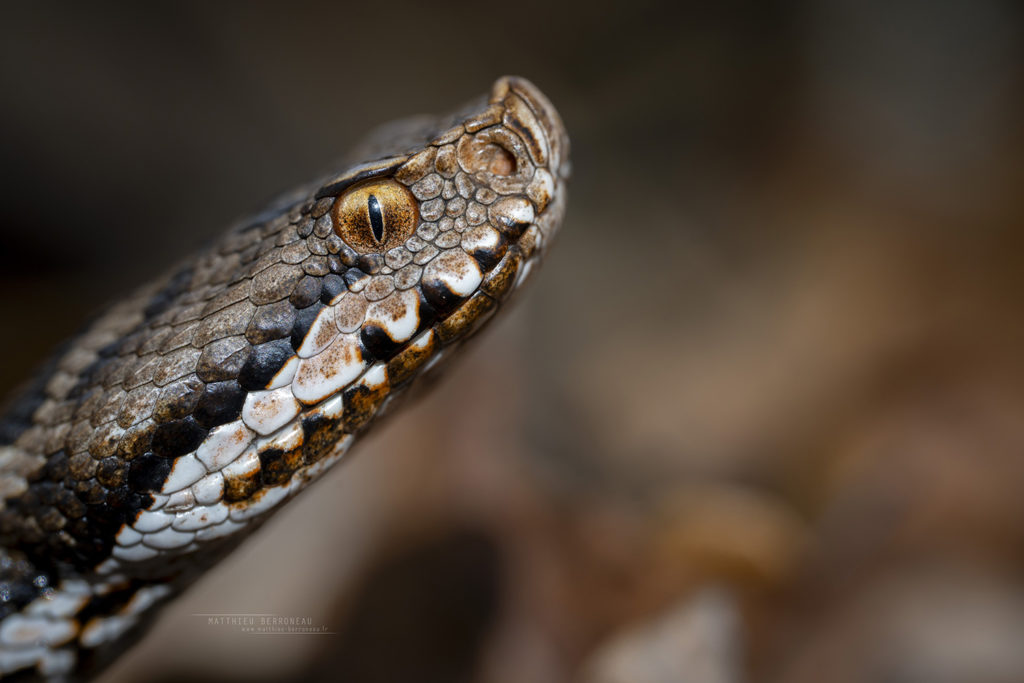
Vipera aspis – Sony FE 100 Macro GM – f5.6 – 1/100s – iso 320
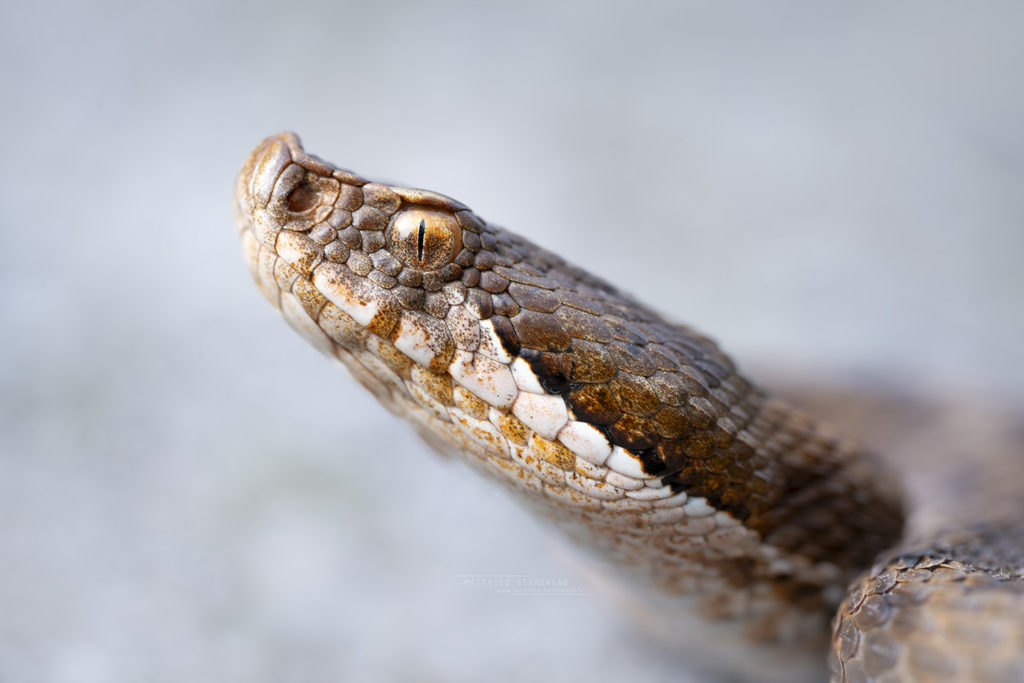
Vipera aspis – Sony FE 90 Macro G – f5.6 – 1/100s – iso 160
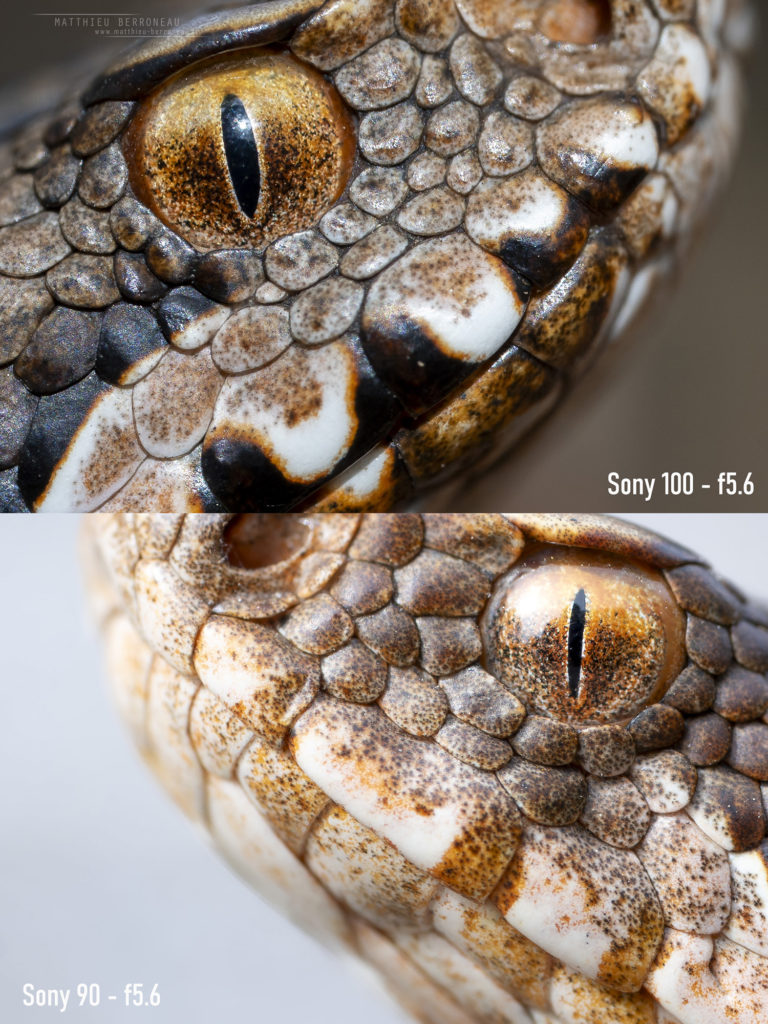
Crop à 100% des deux photos précédentes. La différence de piqué au centre ne parait pas perceptible sur ces clichés – 100% crop of the two previous photos. The difference in sharpness in the center is not noticeable in these shots.
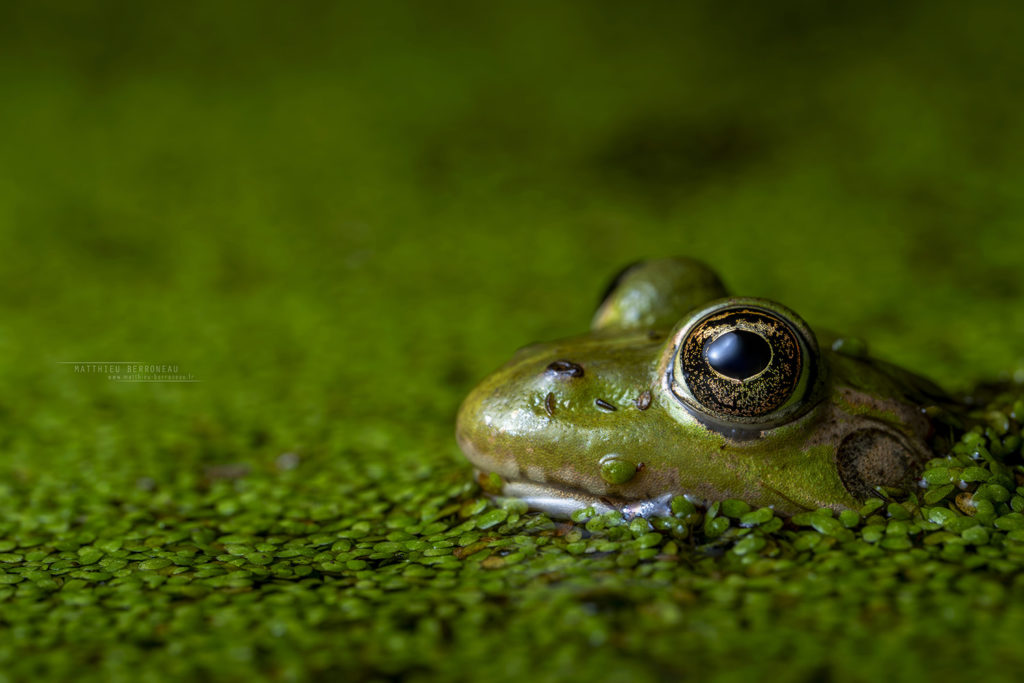
Pelophylax ridibundus – Sony FE 100 Macro GM – f8 – 1/160s – iso 400
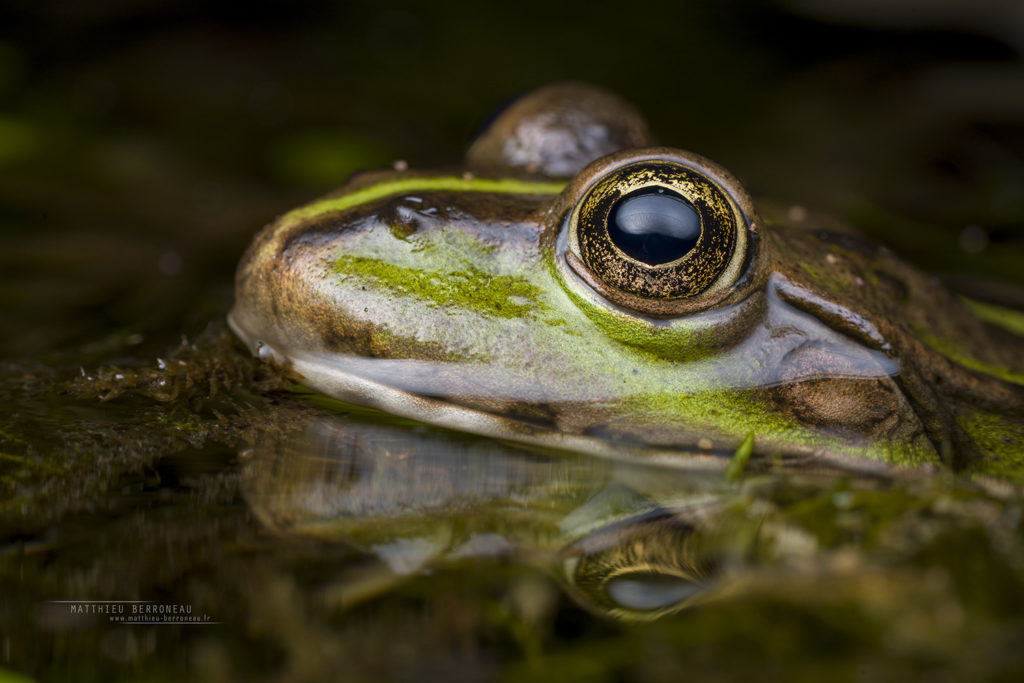
Pelophylax ridibundus – Sony FE 90 Macro G – f10 – 1/160s – iso 200
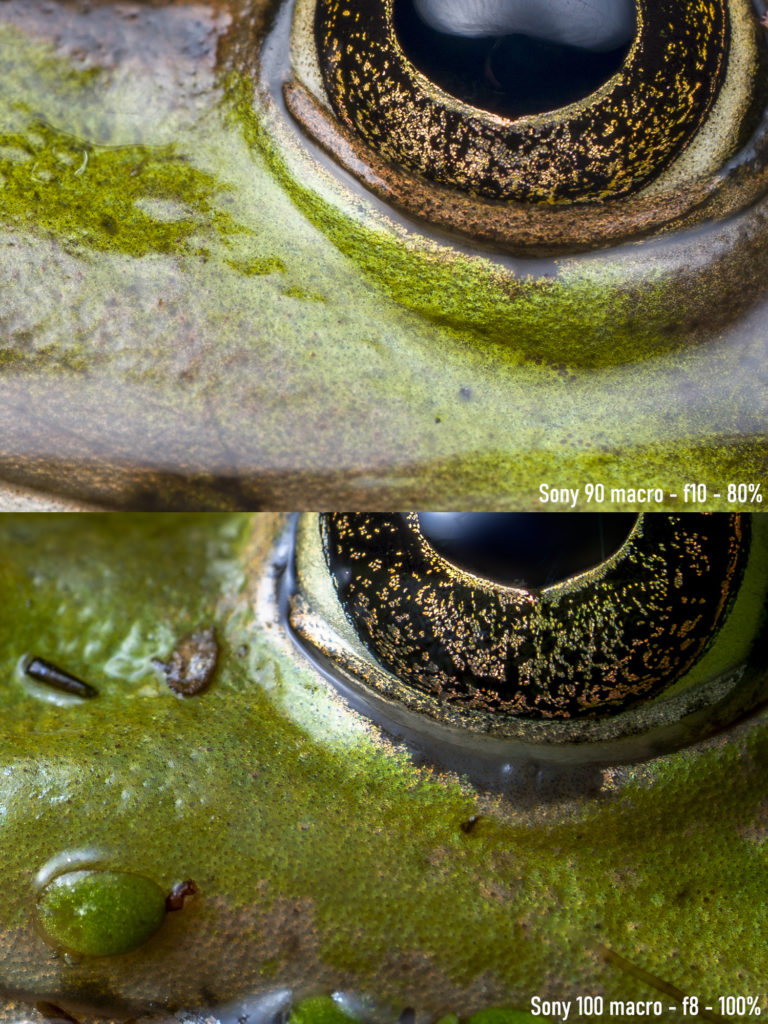
Crop des deux photos précédentes. La différence de piqué est notable ici. Le Sony 100 macro, malgré un crop supérieur, est nettement plus piqué – Crop of the two previous photos. The difference in sharpness is noticeable here. The Sony 100 macro, despite a higher crop, is significantly sharper.
Première conclusion / First conclusion
Le Sony FE 100 macro GM est donc parti pour s’installer de façon long terme dans mon sac photo. La montée en gamme de l’objectif, que ce soit d’un point de vue ergonomie, caractéristiques techniques ou qualité d’image se fait nettement ressentir. Ces deux seuls défauts sont, le prix, en nette hausse par rapport au Sony 90 (à nuancer toutefois car son prix de lancement était, de mémoire de 1100 € environ), et un encombrement à la hausse (1,5 cm de plus en longueur).
C’est le genre d’objectif que j’utilise au quotidien, pour la grande majorité de mon travail photographique, et l’investissement est ici tout à fait justifié. J’ai hâte de pouvoir tester l’objectif avec les multiplicateurs x1.4 voir x2, qui, d’après les premiers tests, ne dégradent que peu la qualité d’image et permettent d’atteindre le grossissement 2.8:1 ! Il pourrait alors remplacer efficacement mon incroyable, mais peu pratique, Laowa x2.5-5 ultra macro. Si vous voulez voir plus de photos, surveillez mes prochaines productions sur Flickr ou sur mes réseaux sociaux. Mes prochaines expéditions en Afrique seront l’occasion de pousser l’objectif dans ses derniers retranchements.
The Sony FE 100 macro GM is therefore set to become a permanent fixture in my camera bag. The upgrade in terms of ergonomics, technical specifications, and image quality is clearly noticeable. The only two drawbacks are the price, which is significantly higher than the Sony 90 (although this should be put into perspective, as its launch price was around €1,100, if memory serves), and its increased size (1.5 cm longer).
This is the kind of lens I use every day for most of my photography work, and the investment is well worth it. I can’t wait to test the lens with the 1.4x and 2x extenders, which, according to initial tests, only slightly degrade image quality and allow for 2.8:1 magnification! It could then effectively replace my incredible but impractical Laowa x2.5-5 ultra macro. If you want to see more photos, keep an eye out for my upcoming posts on Flickr or on my social media accounts. My upcoming expeditions to Africa will be an opportunity to push the lens to its limits.
